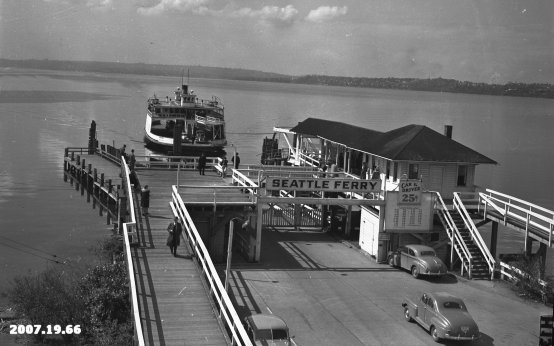Kirkland Ferries – a symbol of prosperity and growth
By Irene Vlitos-Rowe
“New York has its Brooklyn, San Francisco has its Oakland, Seattle is building its Kirkland.”
The East Side Journal, June 19, 1919
In 1919, an East Side Journal advertisement described Kirkland as a: “thriving, fast growing community,” which was at Seattle’s “very door” thanks to its “unexcelled” transportation facilities. Its “phenomenal growth” was being spurred on by an “irresistible movement of population and industry towards the East Side of Lake Washington.” Kirkland had “past the pioneering stage,” and now offered “unusual investment possibilities of its Lake View home sites.”
This description is eerily familiar, with one exception. In 1919, a Kirkland resident had the option to jump ship or, more specifically, take the Kirkland-Madison Park run on the King County ferry and reach Second and Madison within 45 minutes. The ferry left the Madison Park dock at 5.45 am and provided an hourly service until midnight at a cost of five cents.
Kirkland’s proximity to the heart of Seattle was instrumental to its growth, and both the early steamers and ferries played a crucial role in attracting new residents to the area. So when did this all begin and whatever happened to Kirkland’s ferry system?
The story (see Timeline) is one of adventure, struggle and perseverance. Although steamers had been the main mode of transport on Lake Washington since the late 1800s, these were small and did not provide a non-stop service to Seattle. In 1900, due to popular local demand, the King County Port Commission introduced the King County of Kent— the first public ferry on Lake Washington offering a direct run between Kirkland and Madison Park.
By 1908, Captain John Anderson had successfully established the competing Anderson Steamboat Company, which operated a fleet of independent boats on Lake Washington. Always the entrepreneur, he took it upon himself to “steal” passengers away from the county-run ferry a few minutes before they were about to board—a practice which eventually had a negative impact on the public ferry system’s revenues. It was not long before the Port Commission, with support from local businessmen, took action against the fearless Captain Anderson. He was instructed to stay away from the ferry dock at the end of Kirkland Avenue.
If The East Side Journal’s headlines from 1919 through to the late 1940s are anything to go by, Kirkland residents, or East Siders as they were called, were passionate people. There are descriptions of monstrous mass meetings to protect the ferry services, and indignant crowds dressed in full battle regalia who vehemently protested any action to raise ferry rates.
But this exuberance was not enough to sustain the ferry service through a period of declining revenues, the construction of the Lake Washington Floating Bridge in 1940, the elimination of bridge tolls in 1949, and the increase in interurban train routes and automobiles. Although some residents proclaimed that Kirkland without its ferries would be like San Francisco without its cable cars, the end was in sight. On August 31, 1950, the Leschi completed its last run from Kirkland to Madison Park and, as an East Side Journal reporter aptly wrote on that day:”A little bit of Kirkland disappeared forever.”

The ferry Leschi arriving at Kirkland dock,
April 1946, Kirkland Heritage society,
City of Kirkland/Charles Morgan Negative
|
ABBREVIATED TIMELINE |
|
|
Late 1800s |
Boat services began on Lake Washington. |
|
1884 |
The Squak steamer was built, and transported goods and passengers across the lake. |
|
1900 |
The King County Port Commission introduced the King County of Kent—a public ferry service on the Kirkland-Madison Park run. |
|
1908 |
The Anderson Steamboat Company established a fleet of independent boats. |
|
1909 |
Alaska-Yukon-Pacific Exposition attracted more people to the area, and increased passenger traffic on Lake Washington. |
|
1911 |
The Fortuna, a passenger steamer, offered eight daily runs from Madison Park to Kirkland and Juanita. |
|
1915 |
On March 25, the ferry Lincoln, which was owned and operated by Captain John Anderson, began its Kirkland run. |
|
1920-1935 |
Captain John Anderson was appointed superintendent of ferries in 1920, and continued to operate the ferry system until his retirement in 1935. |
|
1940 |
The Lake Washington Floating Bridge. |
|
1940 |
The Lincoln completed its last Kirkland-Madison Park run, and was replaced by the older (and remodeled) Leschi. |
|
1942-1945 |
The ferry system was profitable during the war years. Gasoline rationing made ferry travel more popular with motorists, and the ferry was used to transport workers to the Lake Washington Shipyard where small naval vessels were being built for the war effort. |
|
1949 |
End of bridge tolls |
|
1950 |
On August 31, the Leschi completed its final run between Madison Park and Kirkland. |
|
Sources: The East Side Journal; Kirkland Heritage Society; HistoryLink.org; Steamboats of Lake Washington, Wikipedia; Lake Steamers were essential in early development of Kirkland, Alan J. Stein. |
|
A version of this article appeared in the Kirkland Reporter on May 21, 2008
![]()
![]() ©2008—Irene
Vlitos-Rowe
©2008—Irene
Vlitos-Rowe